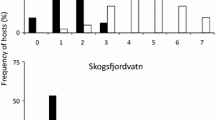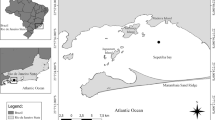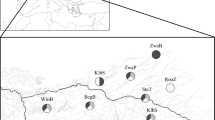Abstract
The relative role of host phylogeny and ecology on parasite community structure is analyzed in three sympatric paralichthyids from Argentine waters: the carcinophagous Xystreurys rasile and the piscivorous Paralichthys isosceles and P. patagonicus. Their relatedness, inherited ecological and physiological traits and shared past histories should result in certain similarities in their parasite assemblages. With this as our null hypothesis, we focused on the effects of measurable traits (size, age and diet) across fish species, with departures from a general pattern being interpreted as a consequence of ecological filters preventing homogeneous infections. The percentage of individuals/species that host-specific parasites contributed to each component community, as well as their effect on similarity of assemblages within/across host species, showed that they were not important contributors to abundance, richness and similarity, being irrelevant for the repeatability within component communities and across fish species as a phylogenetically related group. To minimize the effect of variables other than diet or trophic level only trophically transmitted nonspecific parasites were included in further analyses. After controlling for fish size, the congeneric host species harboured assemblages significantly different from those found in X. rasile, but were similar to each other because of their shared high trophic levels. Assemblages of equivalent structure harboured by fish with different age–size relationships showed that these variables seem to act at dissimilar rates on different features of the parasites assemblages. Indeed, age affected mainly the parasite abundance, whereas body size influenced mostly species richness. In conclusion, similar ecological filters produce analogous infections across host species driving towards homogeneous parasite communities.




Similar content being viewed by others
References
Aguirre-Macedo ML, Vidal-Martínez VM, González-Solís D, Caballero PI (2007) Helminth communities of four commercially important fish species from Chetumal Bay, Mexico. J Helminthol 81:19–31
Alarcos AJ, Timi JT (2011) A new species of Acanthochondria (Copepoda: Chondracanthidae) parasitizing the flounder Xystreurys rasile (Pleuronectiformes: Paralichthyidae) from Argentina. Folia Parasitol 58:164–168
Anderson MJ, Gorley RN, Clarke KR (2008) PERMANOVA + for PRIMER: guide to software and statistical methods. PRIMER-E, Plymouth
Bagge AM, Poulin R, Valtonen ET (2004) Fish population size, and not density, as the determining factor of parasite infection: a case study. Parasitology 128:305–313
Braicovich PE, Alarcos AJ (2007) Redescription of Brasilochondria riograndensis (Copepoda: Chondracanthidae) parasitic on flounder, Paralichthys orbignyanus (Actinopterygii: Pleuronectiformes) from South American Atlantic waters. Acta Parasitol 52:273–277
Bush AO, Heard RW, Overstreet RM (1993) Intermediate hosts as source communities. Can J Zool 71:1358–1363
Bush AO, Lafferty KD, Lotz JM, Shostak AW (1997) Parasitology meets ecology on its own terms: Margolis et al. revisited. J Parasitol 83:575–583
Clarke KR (1993) Non-parametric multivariate analyses of changes in community structure. Aust J Ecol 18:117–143
Clarke KR, Gorley RN (2006) PRIMER V6: User manual/tutorial. PRIMER-E, Plymouth
Clarke KR, Warwick RM (2001) Change in marine communities: an approach to statistical analysis and interpretation, 2nd edn. PRIMER-E, Plymouth
Cousseau MB, Perrotta R (2004) Peces marinos de Argentina: biología, distribución, pesca. INIDEP, Mar del Plata
Desdevises Y, Legendre P, Azouzi L, Morand S (2003) Quantifying phylogenetically structured environmental variation. Evolution 57:2647–2652
Díaz de Astarloa JM, Munroe TA (1998) Systematics, distribution and ecology of commercially important paralichthyid flounders occurring in Argentinean–Uruguayan waters (Paralichthys, Paralichthydae): an overview. J Sea Res 39:1–9
Dogiel VA, Petrushevski GK, Polyanski YI (1958) Parasitology of Fishes. Oliver and Boyd, London (Translated from Russian by Z. Kabata, 1961)
Felizardo NN, Knoff M, Pinto RM, Gomes DC (2009a) Larval anisakid nematodes of the flounder, Paralichthys isosceles Jordan, 1890 (Pisces: Teleostei) from Brazil. Neotrop Helminthol 3:57–64
Felizardo NN, Menezes RC, Tortelly R, Knoff M, Pinto RM, Gomes DC (2009b) Larvae of Hysterothylacium sp. (Nematoda: Anisakidae) in the sole fish Paralichthys isosceles Jordan, 1890 (Pisces: Teleostei) from the littoral of the state of Rio de Janeiro, Brazil. Vet Parasitol 166:175–177
Felizardo NN, Lopes Torres EJ, Gonçalves Fonseca MC, Magalhães Pinto R, Corrêa Gomes D, Knoff M (2010) Cestodes of the flounder Paralichthys isosceles Jordan, 1890 (Osteichthyes–Paralichthyidae) from the State of Rio de Janeiro, Brazil. Neotrop Helminthol 4:113–126
Felizardo NN, Justo MC, Knoff M, Fonseca MCG, Pinto RM, Gomes DC (2011) Juvenile didymozoids of the types, Torticaecum and Neotorticaecum (Didymozoidae: Digenea), from new marine fish hosts (Pisces: Teleostei) in the neotropical region of Brazil. J Helminthol 3:270–275
Fredensborg BL, Mouritsen KN, Poulin R (2006) Relating bird host distribution and spatial heterogeneity in trematode infections in an intertidal snail: from small to large scale. Mar Biol 149:275–283
Guégan J-F, Lambert A, Lévêque C, Combes C, Euzet L (1992) Can host body size explain the parasite species richness in tropical freshwater fishes? Oecologia 90:197–204
Incorvaia IS, Díaz de Astarloa JM (1998) Estudio preliminar de las larvas (Nematoda: Ascaridida) parásito de Paralichthys orbignyanus (Valenciennes, 1839) y Paralichthys patagonicus (Pisces: Pleuronectiformes). Bol Chil Parasitol 53:38–42
Krasnov BR, Poulin R, Mouillot D (2011) Scale-dependence of phylogenetic signal in ecological traits of ectoparasites. Ecography 34:114–122
Lanfranchi AL, Timi JT, Sardella NH (2004) Cucullanus bonaerensis n. sp. (Nematoda: Cucullanidae) parasitizing Urophycis brasiliensis (Pisces: Phycidae) from Argentinean waters. J Parasitol 90:808–812
Lanfranchi AL, Rossin MA, Timi JT (2009) Parasite infracommunities of a specialised marine fish species in a compound community dominated by generalist parasites. J Helminthol 83:373–378
Lester RJG, MacKenzie K (2009) The use and abuse of parasites as stock markers for fish. Fish Res 97:1–2
Lile NK (1998) Alimentary tract helminths of tour pleuronectid flatfish in relation to host phylogeny and ecology. J Fish Biol 53:945–950
Luque JL, Poulin R (2008) Linking ecology with parasite diversity in Neotropical fishes. J Fish Biol 72:189–204
Luque JL, Tavares LER (2007) Checklist of Copepoda associated with fishes from Brazil. Zootaxa 1579:1–39
Luque JL, Mouillot D, Poulin R (2004) Parasite biodiversity and its determinants in coastal marine teleost fishes of Brazil. Parasitology 128:671–682
Magurran AE (1988) Ecological diversity and its measurement. Princeton University Press, Princeton
Marcogliese DJ (1995) The role of zooplankton in the transmission of helminth parasites to fish. Rev Fish Biol Fish 5:336–371
Marcogliese DJ (2001) Pursuing parasites up the food chain: implications of food web structure and function on parasite communities in aquatic systems. Acta Parasitol 46:82–93
Marcogliese DJ (2002) Food webs and the transmission of parasites to marine fish. Parasitology 124:83–99
Marques JF, Santos MJ, Teixeira CM, Batista MI, Cabral HN (2011) Host–parasite relationships in flatfish (Pleuronectiformes) – the relative importante of host biology, ecology and phylogeny. Parasitology 138:107–121
Morand S, Poulin R (2003) Phylogenies, the comparative method and parasite evolutionary ecology. Adv Parasitol 54:281–302
Muñoz G, Grutter AS, Cribb TH (2006) Endoparasite communities of five fish species (Labridae: Cheilininae) from Lizard Island: how important is the ecology and phylogeny of the hosts? Parasitology 132:363–374
Pérez-del Olmo A, Fernández M, Raga JA, Kostadinova A, Poulin R (2008) Halfway up the trophic chain: development of parasite communities in the sparid fish Boops boops. Parasitology 135:257–268
Poulin R (1995) Phylogeny, ecology, and the richness of parasite communities in vertebrates. Ecol Monogr 65:283–302
Poulin R (2000) Variation in the intraspecific relationship between fish length and intensity of parasitic infection: biological and statistical causes. J Fish Biol 56:123–137
Poulin R (2007) Are there general laws in parasite ecology? Parasitology 134:763–776
Poulin R, Morand S (2000) The diversity of parasites. Q Rev Biol 75:277–293
Poulin R, Morand S (2004) Parasite biodiversity. Smithsonian Institution Press, Washington, DC
Poulin R, Mouritsen KN (2003) Large-scale determinants of trematode infections in intertidal gastropods. Mar Ecol Progr Ser 254:187–198
Poulin R, Rohde K (1997) Comparing the richnessof metazoan ectoparasite communities of marine fishes: controlling for host phylogeny. Oecologia 110:278–283
Poulin R, Valtonen ET (2001) Interspecific associations among larval helminths in fish. Int J Parasitol 31:1589–1596
Poulin R, Guilhaumon F, Randhawa HS, Luque JL, Mouillot D (2011) Identifying hotspots of parasite diversity from species–area relationships: host phylogeny versus host ecology. Oikos 120:740–747
Rossin MA, Timi JT (2010) Parasite assemblages of Nemadactylus bergi (Pisces: Latridae): the role of larval stages in the short-scale predictability. Parasitol Res 107:1373–1379
Sasal P, Morand S, Guégan J-F (1997) Determinants of parasite species richness in Mediterranean marine fish. Mar Ecol Prog Ser 149:61–71
Suriano DM, Labriola JB (1998) Redescription of Anonchocephalus chilensis (Riggenbach, 1896) (Pseudophyllidea: Triaenophoridae) and description of A. patagonicus n. sp. Bol Chil Parasitol 53:73–77
Suriano DM, Labriola JB (1999) Diclidophoroides maccallumi Price, 1943 and Neoheterobothrium paralichthyi sp. n. (Monogenea, Diclidophoridae), parasites of fishes (Gadiformes and Pleuronectiformes) from the southwestern Atlantic Ocean. Acta Parasitol 44:160–164
Szidat L (1961) Versuch einer Zoogeographie des Süd-Atlantik mit Hilfe von Leitparasiten der Meeresfische. Parasitol Schrif 13:1–98
Takemoto RM, Pavanelli G, Lizama MAP, Luque JL, Poulin R (2005) Host population density as the major determinant of endoparasite species richness in floodplain fishes of the upper Parana River, Brazil. J Helminthol 79:75–84
Timi JT (2007) Parasites as biological tags for stock discrimination in marine fish from South American Atlantic waters. J Helminthol 81:107–111
Timi JT, Lanfranchi AL (2009) The importance of the compound community on the parasite infracommunity structure in a small benthic fish. Parasitol Res 104:295–302
Timi JT, Lanfranchi AL, Luque JL (2010a) Similarity in parasite communities of the teleost fish Pinguipes brasilianus in the southwestern Atlantic: infracommunities as a tool to detect geographical patterns. Int J Parasitol 40:243–254
Timi JT, Luque JL, Poulin R (2010b) Host ontogeny and the temporal decay of similarity in parasite communities of marine fish. Int J Parasitol 40:963–968
Timi JT, Rossin MA, Alarcos AJ, Braicovich PE, Cantatore DMP, Lanfranchi AL (2011) Fish trophic level and the similarity of larval parasite assemblages. Int J Parasitol 41:309–316
Vales DG, García NA, Crespo EA, Timi JT (2011) Parasites of a marine benthic fish in the Southwestern Atlantic: searching for geographical recurrent patterns of community structure. Parasitol Res 128:261–272
Valtonen ET, Marcogliese DJ, Julkunen M (2010) Vertebrate diets derived from trophically transmitted fish parasites in the Bothnian Bay. Oecologia 162:139–152
Vickery WL, Poulin R (1998) Parasite extinction and colonization, and the evolution of parasite communities: a simulation study. Int J Parasitol 28:727–737
Vidal-Martinez VM, Kennedy CR, Aguirre-Macedo ML (1998) The structuring process of the macroparasite community of an experimental population of Cichlasoma urophthalmus through time. J Helminthol 72:199–207
Yamaguti S (1935) Studies of the helminth fauna of Japan, part 9: I. Nematodes of fishes. Jpn J Zool 6:384–385
Zar JH (1996) Biostatistical analysis. Prentice-Hall, Upper Saddle River, NJ
Acknowledgements
The authors thank Mr. Roque Bruno from Santa Cecilia fish market and Mr. Jorge Ricci, Necochea, for kindly providing fish samples. We also thank Dr. K. MacKenzie (School of Biological Sciences, University of Aberdeen, Aberdeen, Scotland, UK) for his valuable suggestions on the manuscript. Financial support was provided by grants from CONICET (PIP 112-200801-00024), FONCyT (PICT 02199/07) and Universidad Nacional de Mar del Plata (EXA 531/10).
Author information
Authors and Affiliations
Corresponding author
Rights and permissions
About this article
Cite this article
Alarcos, A.J., Timi, J.T. Parasite communities in three sympatric flounder species (Pleuronectiformes: Paralichthyidae). Parasitol Res 110, 2155–2166 (2012). https://doi.org/10.1007/s00436-011-2741-5
Received:
Accepted:
Published:
Issue Date:
DOI: https://doi.org/10.1007/s00436-011-2741-5




